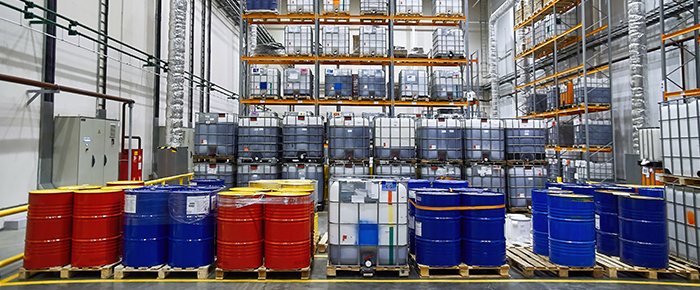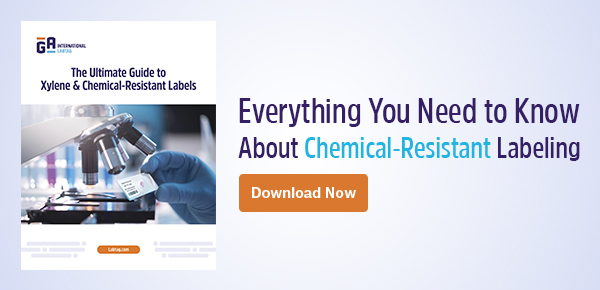
When it comes to biomedical research labs, safety is often in the hands of the user, who continually navigates an environment filled with potentially hazardous chemicals. To help mitigate the risk of accidental exposure to these chemicals, here are several tips to better account for, handle, and dispose of your chemical stocks.
Research the chemical
Knowing the risks is essential to understand what steps should be carried out to protect yourself. With such a massive variety of chemicals used in any given assay, it’s crucial to know whether the chemical releases toxic fumes or can soak past lab gloves. It’s also valuable to understand the concentrations necessary to produce an adverse reaction and under what conditions it does so, including potentially hazardous reactions it may have with other chemicals. The best starting place to ascertain this knowledge is often the safety data sheet (SDS) of the chemical, which contains information on the type and level of the hazards it poses. Ensure your SDS is up-to-date and contains all essential information.
Wear proper PPE
Personal protective equipment (PPE) represents the most important barrier between you and the chemicals you work with. Prior to working with chemicals, a thorough hazard assessment should be performed for each station to understand the potential risks and select the right equipment. Regardless of the compound, nitrile gloves should be worn in the lab when performing chemical and/or biochemical assays, in addition to a lab coat and proper eye protection. Usually, safety glasses are enough to prevent accidental exposure, but more advanced protection in the form of chemical splash goggles, face shields, fume hoods, or biosafety cabinets can also be used. Always wear closed-toe shoes in the lab to completely cover your feet.
Regardless of the level of PPE, always keep a safe distance from the chemical. If toxic fumes are an issue, make sure to lean your head back, away from containers harboring the chemical, and perform manipulations in a well-ventilated area without directly contacting the solution or powder. In case of exposure, eye washes, and showers should also be located nearby.
Visibly label containers and track usage
One of the most important aspects of lab safety is clearly identifying potential hazards. For containers, it is recommended to use thermal-transfer printable chemical-resistant labels. This is to ensure that all containers are consistently and accurately labeled such that other personnel can clearly view the contents of all hazardous chemicals in the lab. These labels will resist most long-term exposure to harsh organic solvents and other chemicals that can either cause the label to lose adhesion or smear the printout.
To make the most of chemical-resistant labels, it is advised to print them with 1D or 2D barcodes in addition to alphanumeric text and/or integrate an RFID-based identification system. In conjunction with a laboratory management information system (LIMS) or electronic notebook (ELN), barcode labels and/or RFID can be used to track not only the identity of all toxic reagents but also register how much was used, the date of use, the specific user, and whether an incident occurred, among other workflow-related data. By tracking every step of the process, problems can be quickly identified and troubleshooted, guaranteeing a higher level of lab safety.
Store and dispose of chemicals safely
The first step in storing hazardous chemicals is to ensure they are in their appropriate cabinet. Fume hood cabinets are useful for storing flammable and/or highly acidic or basic chemicals. However, storing chemicals away from hazards, like potential heat sources, isn’t enough. It’s recommended to use secondary containers to prevent spills and limit damage should one occur. Remember to label these secondary containers as well; if the original bottle is separated from the secondary container, it is necessary to inform personnel what type of chemical has been spilled into the container. Additionally, do not forget to affix clear warning labels to the doors of the cabinets where these chemicals are stored.
Disposal is equally essential when it comes to mitigating risk. Provide personnel with the appropriate containers to dispose of chemical waste, taking into consideration their composition to avoid the chemical reacting with and compromising its integrity, which can cause spills. Disposal of gloves, sharps, and other equipment should also be considered, as potential contamination to the rest of the lab can occur if these items are not dealt with safely. Remember never to wear gloves outside the lab, as this can quickly contaminate common areas where PPE is not worn.
Plan for accidents
While the goal of accident prevention is to reduce the risk to zero, the ongoing possibility of human error means that, in reality, there is always some amount of risk that must be accounted for. That’s why there should always be SOPs available to all staff, accessible via cloud-based LIMS or ELN, for adverse events caused by chemical exposure. These SOPs should cover the various classes of chemicals that personnel may encounter, along with step-by-step instructions on mitigating the damage, resolving the incident, and reporting the event. Training should also be supplied for handling specific types of chemicals, including treating injured and/or contaminated personnel.
LabTAG by GA International is a leading manufacturer of high-performance specialty labels and a supplier of identification solutions used in research and medical labs as well as healthcare institutions.



